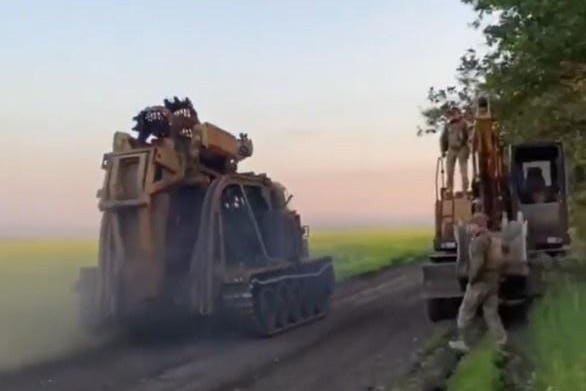On a battlefield practically crawling with weird and rare combat vehicles, the BTM-3 might be the weirdest and rarest. It’s not a tank. It’s not an infantry fighting vehicle. It’s not even an armored engineering vehicle—a class of vehicle that lends itself to extreme specialization.
No, the BTM-3 is a trencher. And as its name implies, it does one thing: digs trenches. The 37-ton, two-person BTM-3 combines the chassis of a diesel-powered AT-T heavy artillery tractor—itself based on the chassis of a T-54 tank—with a chainsaw-style excavator.
A BTM-3 can dig a trench five feet deep and three feet wide at a rate of up to 800 yards an hour. As far as excavation goes, that’s fast.
While we might expect the Russian army to deploy Soviet-vintage BTM-3s—the Russians after all built hundreds of miles of trenches last winter and this spring as they shifted to the defensive across most of Ukraine—BTM-3s also work for the Ukrainian army.
A video that circulated online on or before Tuesday depicts one of the Ukrainian army’s estimated 10 ex-Soviet BTM-3s speeding along a dirt road in Zaporizhzhia Oblast in southern Ukraine.
Zaporizhzhia is one of the locuses of Ukraine’s long-anticipated 2023 counteroffensive, which kicked off on June 4. Ukrainian brigades since then have advanced a few miles along several axes.
Trenches have defined the fighting. The Russians dug trenches in order to slow the Ukrainians’ advance; now the Ukrainians are digging them in order to consolidate their territorial gains.
It’s apparent that BTM-3s—along with other military trenchers such as the Russian BTM-4 and Ukrainian PZM-3—have played a leading role in preparing these trenches, alongside civilian excavators.
These military trenching vehicles are far more common across the former Soviet Union than they are in the West. Soil and climate help to explain why.
“Engineers and planners in the Soviet Union obviously perceive a significant need for cutting trenches in frozen soils,” the U.S. Army Corps of Engineers noted in a 1980 report. “By contrast, there has not been a great deal of trenching in frozen soils in North America.”
It was entirely predictable that trenches would dominate the current phase of Russia’s 18-month-old wider war on Ukraine. Trenches thread through Russian army doctrine, which the Ukrainian army to a great extent also still follows.
When a Russian or Ukrainian brigade is on the defensive, even temporarily, it will dig in. Literally. “The work of trenching machines and bulldozers will be supplemented with old-fashioned shovels to provide protection for men and equipment,” Lester Grau and Charles Bartles explained in their definitive The Russian Way of War.
Civilian contractors do a lot of the work. But it’s expensive, and dangerous for the crews, for an army to hire civilians to do soldiers’ jobs. Contractors working for the Russians lost so many excavators and operators to Ukrainian drone strikes in late 2022 and early 2023 that the Russian army rushed improvised air-defense vehicles to the front and assigned them to escort the contractors while they dug.
Wherever possible, the Russian army has deployed its own trenchers. But there’s scant footage of them in action along the front line. A video that appeared online late last year depicts a BTM-3 digging trenches in Luhansk Oblast in eastern Ukraine.
But it’s obvious the weird trenchers have been busy in Zaporizhzhia, too. On both sides of the conflict.
Read the full article here





